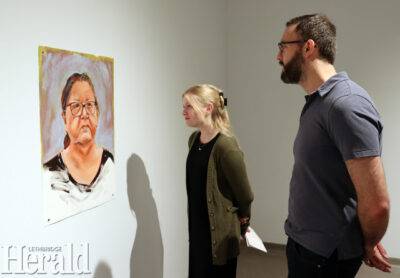Exhibit does an ‘Untelling’ of portraits of Indigenous peoples
By Al Beeber - Lethbridge Herald on October 5, 2024.
 Herald photo by Al Beeber
U of L art gallery's Kirsten Meiszinger and David Smith look at a portrait of Kainai artist Faye HeavyShield done by artist Lauren Crazbull as part of a new exhibit that opened Friday.
Herald photo by Al Beeber
U of L art gallery's Kirsten Meiszinger and David Smith look at a portrait of Kainai artist Faye HeavyShield done by artist Lauren Crazbull as part of a new exhibit that opened Friday.LETHBRIDGE HERALDabeeber@lethbridgeherald.com
Artist Lauren Crazybull is “Untelling” the work of painter Nicholas de Grandmaison with a new exhibit that opened Friday at the University of Lethbridge in the Dr. Margaret (Marmie) Perkins Hess Gallery.
Blackfoot and Dene artist Crazybull, who now lives in Vancouver is a member of the Kainai First Nation and Alberta’s first provincial artist in residence.
Curated by Josephine Mills, the exhibit runs until Jan. 11. An official grand opening was staged on Friday at 3 p.m.
In a synopsis of her work, Crazybull says she “considers Indigenous presence and multiplicity through paintings, creating worlds where honest portrayals trespass onto romantic representations of Indigeneity.”
The exhibit juxtaposes works by Crazybull who works in paint and photography with the art of de Grandmaison, a Russian-born portrait artist who worked in the 20th century from the 1930s to 1960s.
de Grandmaison portrayed Indigenous people through a stereotypical lens, presenting them in images that were stoic, sorrowful or with shades of romanticism because he was convinced that Indigenous people were disappearing, a concept that David Smith of the university who hung the show called racist.
Kirsten Meiszinger, program curator for the U of L art gallery, said Crazybull has just finished her Masters of Fine Arts and is doing the exhibition in response to de Grandmaison’s historical works.
“We have the largest holdings of Nicholas de Grandmaison’s works within the university art gallery collection and he was a settler Canadian who depicted Blackfoot people in this area,” Meiszinger said.
“They were made with the stereotypical lens of the stoic, noble or romanticized view and gaze of the Indigenous peoples, the curator said.
“She’s untelling and retelling the story of the local Indigenous community,” Meiszinger said of Crazybull’s work.
The artist came to the U of L to do research on De Grandmaison’s work about a year ago and a collaboration was done on the exhibition.
The exhibit has 10 paintings on paper inside the gallery along with one canvas outside the gallery and one photograph by Crazybull who works in oil on paper, oil on canvas as well as photography.
“She’s particularly well known for her portraiture. She’s done major commissions for Time magazine, Chatelaine and Penguin/Random House. She’s got a very successful commercial practice,” said Smith.
“We’re all very excited about it,” added Smith of the exhibit.
One portrait in the exhibit is of Faye HeavyShield, an internationally acclaimed artist from the Kainai Nation who has just received a major commission for the renovation of the Glenbow Museum in Calgary.
One image in the exhibit is a contemporary painting of a man named Joseph Yellowhorn who is also portrayed in an older painting by de Grandmaison in the exhibit.
“The de Grandmaison portraits are complicated. She likes the complexity of them,” Smith said of Crazybull.
“There’s notions of Indigenous people as disappearing and needing to capture them before they’re gone which of course is offensive and racist and Eurocentric, and very problematic,” added Smith.
“But de Grandmaison was really passionate about doing portraits of Indigenous people and he was really embraced by the Blackfoot,” Smith added.
“The portraits are always very colourful and very respectful but they’re also romantic and sometimes sorrowful,” he said, with Meiszinger noting “they play into stereotypes.”
“There’s a pretty big difference between a white person doing a portrait of an Indigenous person and Indigenous person doing portraits about their Indigenous people,” added Smith.
In her artist statement, Crazybull wrote “I’m conscious of the coupling of sorrow with Indigeneity and the idea that Indigenous people belong to the past. I’m aware of disappearance in relation to Indigeneity. I’m not interested in correcting or refuting these ideas but I would like to see how it feels to place by painted portarits next to de Grandmaison’s pastels.”
In June and July of this year, the artists travelled around southern Alberta to photograph Blackfoot people in her home community of the Kainai Nation, shooting images in Lethbridge as well as Cardston, Brocket and Standoff.
Crazybull photographed 17 people
“The prairies feel infinite, the landscape uninterrupted. The places we passed in the care all bear memories, this is evident through how the landscape is shaped, named and interacted with. I hold only fragments of his memory,” Crazybull wrote.
“Other fragments of memory exist in de Grandmaison’s work. The works of his I selected for Untelling are predominantly unfinished. The figures seem to fluctuate between disappearance and emergence. Something is kept from the viewer and an elusiveness exists in the spaces left blank.”
The exhibit, Crazybull wrote, ” is a declaration of existence and an expression of love to my Blackfoot family and friends who live with humour, strength and refuse to settle within imposed boundaries.”
29-28


